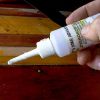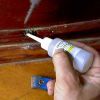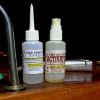“Why they call Cyano-Acrylate super”
Or superglue to everyone else…..cyano has been available to the model aircraft builders for many years and they have been using it to good effect; the beauty of the glue is that it actually uses the lack of air and the moisture content in the substrate to set the glue. It won’t set if the wood is actually wet…but it just loves the normal moisture content of wood. You don’t have to dry the wood right out like you would with epoxy. Think how super-glue sets on your fingers….wood is the same! It’s a true instant fix for cuts and cracks about the boat.
One of the most anoying problems I have (particularly on Fairey boats) is the slow movement of either the veneers or the edge of ply decking. The wood moves and the varnish cracks….no problem…until the water starts to get in…..and then it is a pain to fix.
The first problem is finding the cracks! well at least it is before the water gets in and it’s to late. I have been known (and seen) to go along giving my decks a long french kiss….sucking the seams….it certainly gets a few comments…but also finds many cracks. The other way is to go for a sail and then watch out for any cracks that look dark or show a wet edge after boat has dried out.
OK once you have found them the thing to do is to run a scalpel or stanley down the seam/crack/join; not deep and try not to cut any new gap, you are just trying to open out any seem that is truly unstuck. Sometimes the blade is tight and sometimes it just sinks right in…..Ugh….bet you glad to it then and not later.
OK the first thing is to dry it out a bit if it needs it. Now as I said….it don’t need to be dry, dry, dry but you equally well don’t want any sodden wood locked under the varnish.
Once dryish (well no visible dampness) you just run the cyan down into the crack. Cyano is available in various thicknesses and for this you want the thin stuff. It is so thin that it will just run right down and into the cracks. Drop it one place and you see it run right up the crack to the other end. A couple of drops is all it takes, keep a rag to hand to get any other drips that might get away from you. Some woods will set the glue so fast that you will actually see it steam any dampness about in wood. Some woods are slower and for these you can use a bottle of accelerator.
The glue might take anything from a few secs to a few mins to set. basically it sets quick down in the cracks where there is no oxygen and a little dampness but can take longer where it runs down over the top of the varnish.
Take a Stanley and scrape the set glue and loose varnish that has set around the edge of the filled crack. When it is flatish you can sand it as well. Then a quick coat of varnish and you have a nice and instant fix.
I always considered this a bit of a bodge fix, but I have seen cracks fixed like this which have needed no more work for years.
It works beautifully with wood….but can be effective on GRP, ali, brass….even stainless. I fixed a mast tip sheeve for some cadets 420 and told them it was just for the race……that was 4 years ago….and they have never touched it since!!
Cyano Acrylate is available from many sources and is not too expensive. I normally buy from Model Aircraft guys and my last stash was 3 bottles of glue and 1 activator and this lasted me over a year and cost 10 pounds.
Wonderful stuff…..no bits box can be without a couple of bottles.




